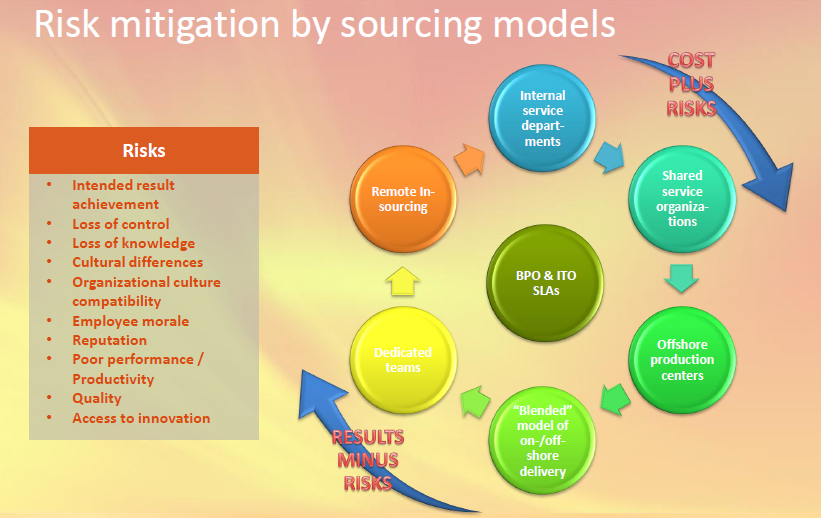 If you are planning on outsourcing some business activities it is vital to understand your options before deciding on an outsourcing partner. Every vendor will have their own understanding of how their model can help you – it is important that you know what these models mean, what risks they are designed to mitigate, and which one is most compatible with your goals.
If you are planning on outsourcing some business activities it is vital to understand your options before deciding on an outsourcing partner. Every vendor will have their own understanding of how their model can help you – it is important that you know what these models mean, what risks they are designed to mitigate, and which one is most compatible with your goals.
Some outsourcing risks are prevented by legal agreements, others are mitigated by vendor maturity (for a full explanation, view this presentation). Yet others are mitigated by outsourcing models. Risks that can be mitigated by outsourcing models include:
- Intended result achievement
- Loss of control
- Loss of knowledge
- Cultural differences
- Compatibility with organization’s culture
- Employee morale
- Reputation
- Poor performance/productivity
- Quality
- Access to innovation
Below are 7 common outsourcing models. How do they compare based on cost and risk mitigation?
Internal Service Departments
With this model companies have their own developed infrastructure and house their own services that they utilize. The service departments can vary anywhere from printing to software development. Internal service departments are an insourcing model that can be achieved by staff augmentation or internal hiring. It is often very costly to create and maintain (cost of infrastructure, hiring employees etc). It eliminates most of the risks above as all processes become part of internal management, but it is a costly long-term investment.
Third party service contracts (domestic or foreign)
When a company doesn’t have the capacity (or the intent) to build out an internal portion of their own company, they may choose to contract a third party provider instead. For example, this outsourcing strategy could include an IT company that services computers or a software consultant who checks the company’s processes. This is essentially a type of out-tasking and is often project-based. Most of the risks are dealt with in the contract, but that does not mean the client is risk-free. Some of the risks that the client may still face include knowledge management, reputation, compatibility, quality and performance issues. Not achieving the intended result, extra training costs and not having access to innovation may be some other issues as well.
Shared Service Organizations
Shared service organizations are created when a group or a company extends their capabilities by partnering with another organization. It is then able to use the services as if they were internal resources. Shared services imply that every organization utilizing those services carries the same responsibility, and the same risks, as everyone else. For example, a software development provider may extend their HR capabilities to a software product company so both can utilize the same labor resources. While utilizing shared services mitigates risks such as reputation and organizational compatibility, this outsourcing model presents its own unique challenges when moving work to a central location such as rework, duplication, longer delivery times, loss of knowledge, loss of control, and product quality.
Offshore Production Centers
When a company has constant demand for a particular service, wants full control over operations and cost-savings, and does not want shared responsibility, they might consider creating an offshore production center. They can do this either by establishing a captive center themselves in another location or by contracting a vendor to guide them through the process. This can be achieved through staff augmentation or a build-operate-transfer strategy. While the Production Center allows full control over operations, it comes with a high price tag for set-up and further maintenance costs that may be further complicated by conditions in the offshore locations. The company may also face risks such as low employee morale, cultural differences, loss of knowledge, reputation, and poor performance.
Dedicated Teams
Sometimes a company needs dedicated resources, but is not willing to create an internal or an offshore production center. To get the right resources they choose to contract a dedicated team from a provider. For example, dedicated teams are a good solution for a company that needs constant support for mobile application development, but does not have the resources in-house and does not want to be responsible for an entire specialized organization. This model mitigates risks such as loss of control or knowledge, problems with employee morale, reputation, and quality of product. It also cuts costs of infrastructure and operations of previous models. The success of the team, however, still relies on organizational compatibility, and clear communication and cooperation between in-house staff and the dedicated team. Depending on the vendor they may be some extra training costs as well.
Blended model of on/off shore delivery
Companies that want dedicated resources that are located elsewhere but want direct internal control over their projects may opt for a blended delivery model. Typically the model assumes a project manager or IT consultant on-site that manages an external or offshore team located elsewhere. This further minimizes risks of losing control or knowledge, but is often a more costly investment because of the on-site component.
Remote Insourcing
Remote Insourcing is a direct link between outsourcing and insourcing models. It builds upon the dedicated team model, but works towards eliminating organizational and cultural compatibility problems, clears up communication, and minimizes costs (training, infrastructure etc.). It draws on the best of both worlds: cost-efficient resources (such as the dedicated team) and optimal control (such as internal service departments). With this model a vendor creates a remote IT unit of dedicated resources staffed with people that are directly selected to meet the client’s needs. It mitigates risks such as loss of control, loss of knowledge, organizational and cultural compatibility, poor performance and poor product quality. The client does not have to pay for operations or logistics of their team, and they can enjoy access to innovative resources without hurting their reputation or employee morale.
For a more in depth look at outsourcing models, check out this article.

Title image via Graphicstock
